For many the sculpture of ancient Greece is almost a synonym for Greek culture itself. Sculpture did indeed play an important role in Greek life, and the many ways—architectural, funereal, commemorative, public and private, secular and sacred—in which the Greeks used sculpture are illustrative of this vital role.
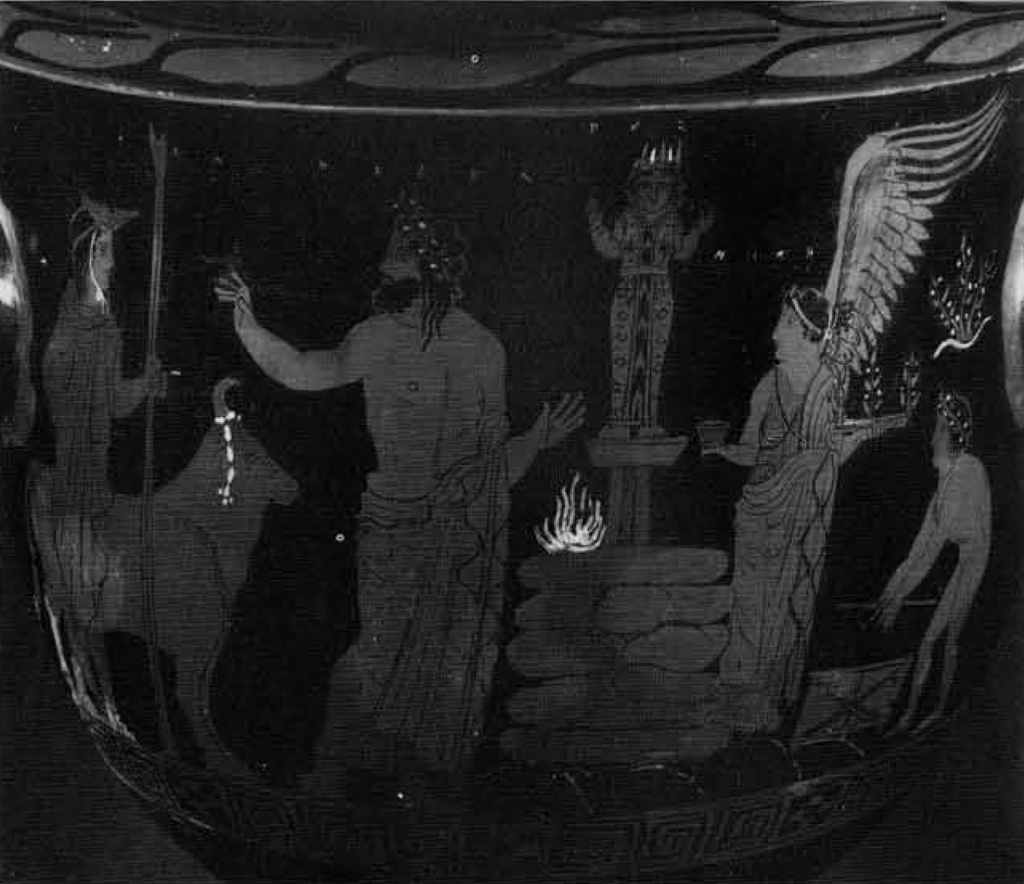
A long neglected topic in this otherwise comprehensive scholarly field is the most sacred and revered of all Greek sculpture, the cult idol. The very importance of idols in Greek religious thought and practice makes an examination of this subject of more than a little interest to classical scholars as well as to the layman with a knowledge of the development of western culture. The first appearance of idols in the late 9th century B.C. and their early history in the 8th, 7th and 6th centuries B.C., a period during which Greek religion becomes formalized in its ideology and ritual, that is of most compelling interest to us. Why then has no scholar attempted an explanation of these early idols, their appearance or cult significance?
The answer probably lies in the scattered and limited nature of the evidence. In the abundant ancient literary sources on Greek life, the references to idols are few and are found in the works of various Greek and Roman authors who mention these statues only obliquely. Information from ancient inscriptions is also limited but the evidence they supply is of a more specific nature. It is only by piecing together these literary and epigraphical references and combining them with archaeological clues that a picture emerges of the general appearance and role of idols in early Greece. The archaeological evidence which is of such importance for this study comes in the form of surviving bases on which these statues once stood, painted depictions on vases, representations on coins and in relief sculpture, and large- or small-scale works of sculpture.
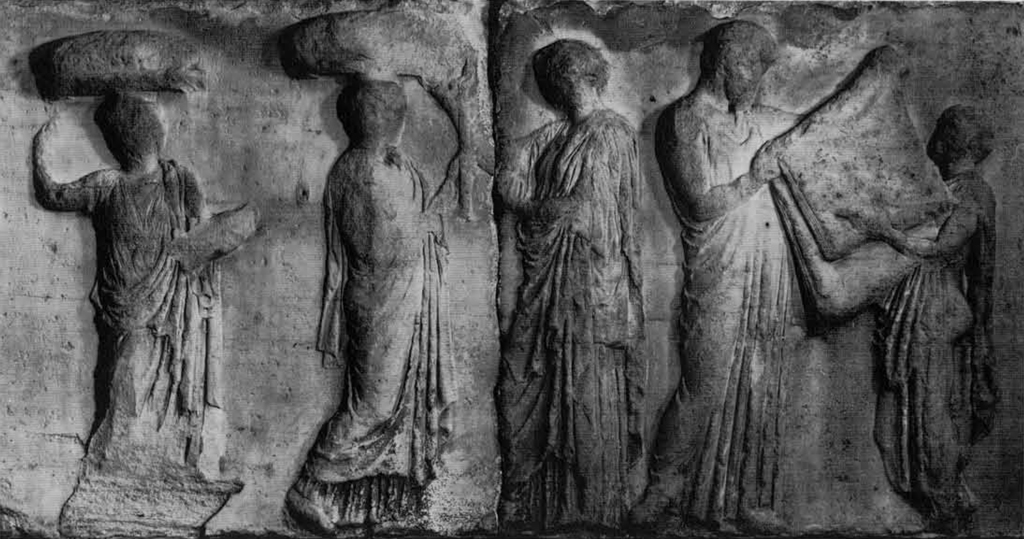
Our dependence on all these secondary sources for knowledge of Greek idols is understandable only if one realizes that, although every Greek temple housed such an idol and every Greek city and sanctuary had at least one and often many temples and shrines with such images, there are few surviving Greek statues which can be positively identified as idols. Christian iconoclasm and the decline of pagan Greek cults during the course of the Roman Empire, the perishable or precious materials of which these idols, especially the earliest ones, were made and the inevitable ravages of time are all factors which contributed to the virtual disappearance of the idols of ancient Greece.
In ancient Greece an idol can be defined as a scuptural image of a divinity which served as the major representation and focus of worship of that divinity at a particular shrine or sanctuary. These idols were, in a sense, earthly substitutes or symbolic manifestations of the presence of gods or goddesses, and for this reason idols were considered very sacred objects. It is probable that Greeks had various ideas about what an idol was or what it signified, but it is doubtful that any Greek, no matter how fervent were his religious beliefs, held that an idol was the actual god or goddess.
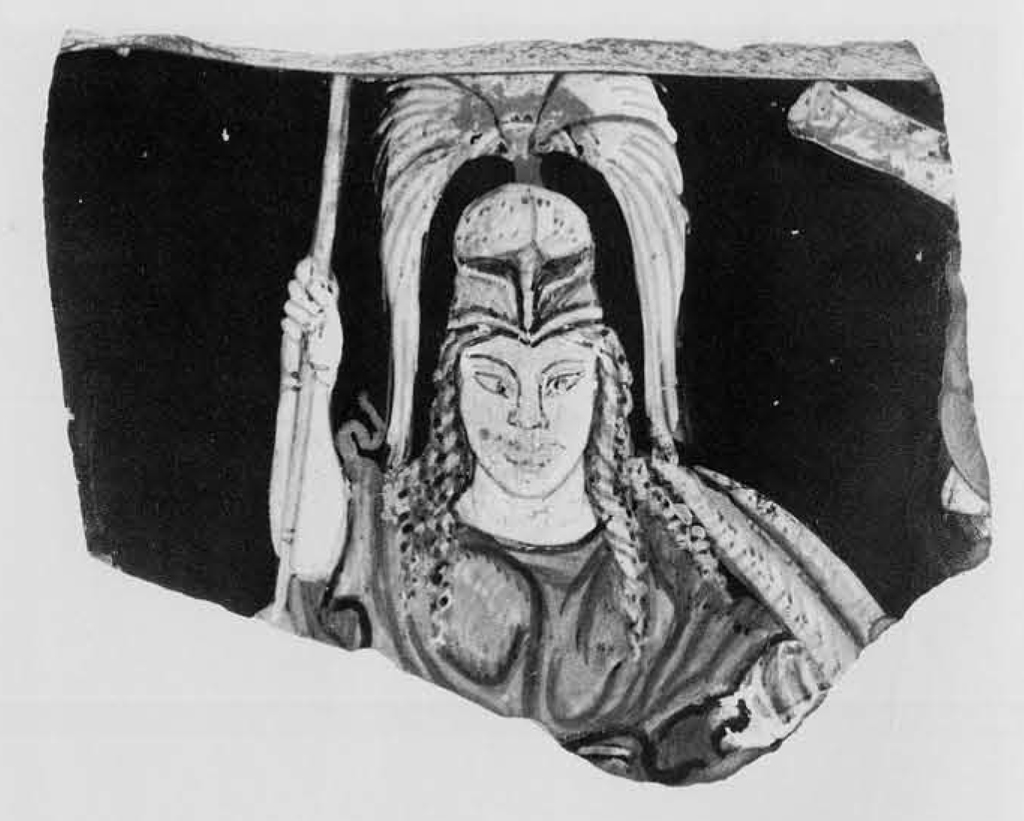
Idols were distinguished in function from other representations of deities, for example, from statues given as dedications by an individual or city and set up in a sanctuary, by their special setting and their primary role in cult activities. Idols were most commonly given the honor of a grand home in a temple. One should remember that idols were the reason that temples were built in ancient Greece. In fact, it may be argued that Greek temples arose as a result of the origin of idols, with the need of providing a dwelling (a naos) for these divine earthly surrogates. The development of the temple-form of architecture and of idols follows a parallel course. As the Greek temple evolved quickly into a canonical form, becoming by the 6th century B.C. a standard feature of Greek sanctuaries, so too the concept of one special sculptural representation of a deity gained in popularity and by the 6th century B.C. idols had become almost ubiquitous in Greek sanctuaries.
Some Greek idols, however, did not dwell in temples, but rather were set up in open-air sanctuaries, sometimes on pillars or columns, as is shown by representations on Greek vases (Cover and Fig. 1). The colossal 45 foot high, hammered bronze idol of Apollo at Amyklai near Sparta stood outdoors, on a throne and surrounded by an architectural complex. The setting, crowning a hilltop, was spectacular and Apollo could not have been displeased with the effect. Sometimes idols which were worshipped outdoors, particularly in the rural shrines of Arcadia, were aniconic, i.e. without human shape, and took the form of rocks, pillars or trees. Although it is a popular notion that aniconic images are a phenomenon only among ‘primitive’ societies, it is clearly not possible to characterize the Greeks of the 8th, 7th or 6th century B.C. as primitive. Furthermore, it can be demonstrated that aniconic and anthropomorphic idols were contemporary phenomena in Greece. However, the evidence suggests that idols which were housed in temples were always anthropomorphic in form.
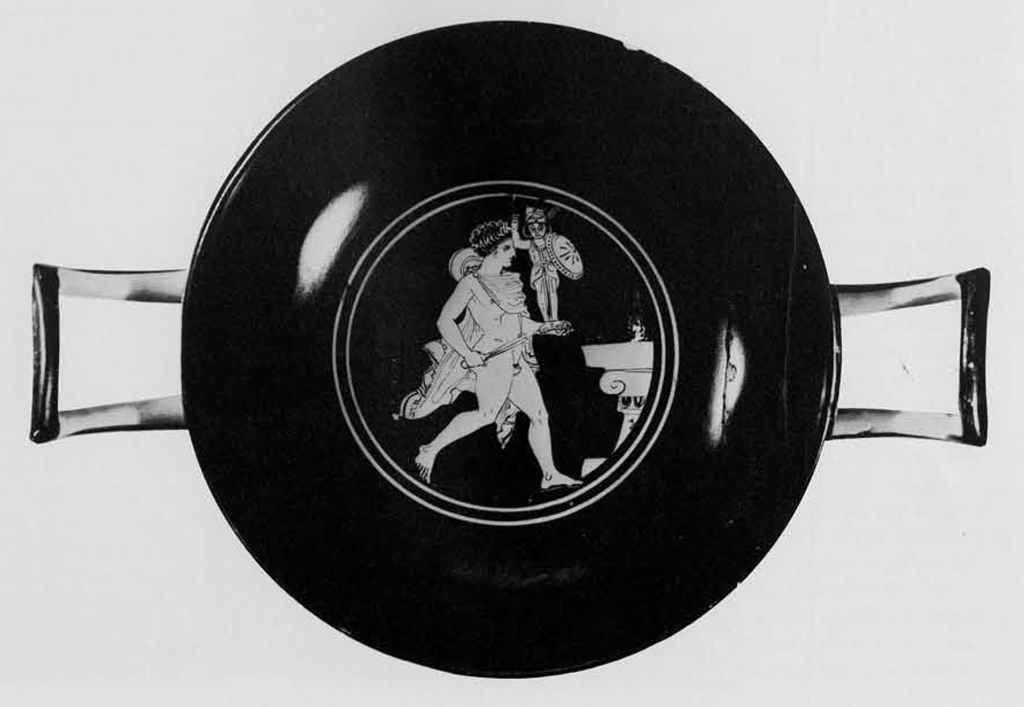
Rites and ceremonies, especially sacrificial ones, in which idols played a major role set these images apart from other sculptural representations. It should be noted that, despite the popularity achieved by idols, they were not the most important feature of a Greek sanctuary. The primary element of a Greek sanctuary, the element without which the sanctuary could not exist, was the altar rather than the idol or the temple building in which it was housed, and sacrifice was much more vital to Greek cults than the revering of idols ever was. But, when there was an idol, it was toward this image, as the substitute for the deity, that sacrificial acts were directed. Idols were usually placed in close physical relation to the area where sacrificial gifts were being offered to the deity. In the ‘canonical’ sanctuary setting where the temple faced east toward an exterior altar, the idol was placed looking eastward toward the front door of the temple and toward the altar.
Besides sacrificial acts, prayers and the offerings of libations and votive gifts, there were in some cults other rituals directly involving the idol. For example, we know that some idols, especially small wooden ones, were removed from their bases and carried in processions on festival days. For no other ancient ritual can one find a more precise modern parallel than the processions in Italy, France and Spain where images of the Virgin and saints are carried through the streets on feast days. In ancient Athens, on the first day of the festival of the Great Dionysia, the wooden idol of Dionysos Eleuthereus was removed from the temple in the theater precinct and carried to a shrine in the Academy where a sacrifice was offered and hymns were sung by young men.
Bathing, clothing and feeding idols are also attested in connection with such processions. On the East Greek island of Samos, during a festival entitled Tonaia, the small wooden idol of Hera was carried from her temple to the nearby seashore, purified, perhaps by bathing the statue in the sea, and fed a meal of barley cakes. The wooden idol of Artemis at Ephesos, on the coast of Asia Minor, was also carried in a procession to the sea, adorned with a new wardrobe and fed a meal of salt.
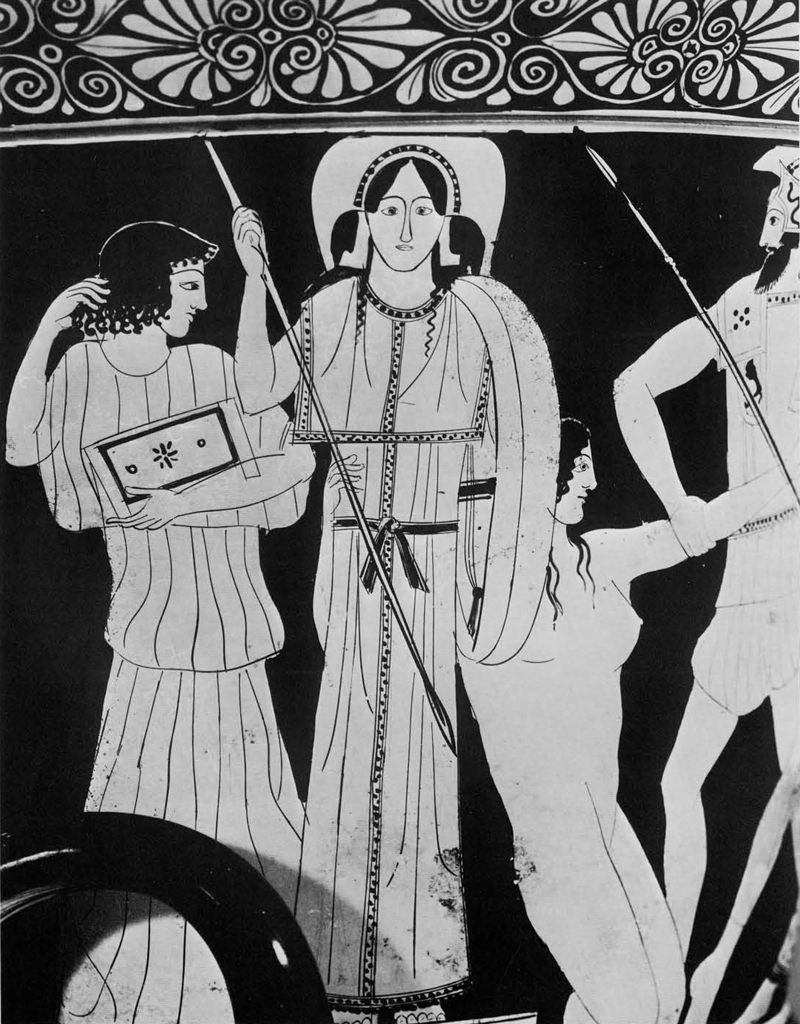
The ritual dressing and adorning of idols in actual garments, jewelry and accessories, a practice also attested in cuneiform tablets for Babylonian idols, was probably common in ancient Greece especially in the case of wooden images. The most famous of Greek clothing rituals concerns the wooden statue of Athena Polies, the most important and revered idol of Athens, indeed the very symbol of Athens. On the occasion of the Great Panathenaia, every four years, a new dress (a peplos) was presented to Athena (Fig. 2), and during two other yearly festivals Athena’s garments were cleaned by specially appointed priestesses and the statue was secretly dressed in the cleaned garments.
Some idols are known to have worn many garments at once. According to 4th century inventory accounts, the wooden image of Artemis at Brauron near Athens wore up to five garments at the same time. It is clear from these accounts that Artemis received masses of dedications, many in the form of used or children’s clothing which were never meant to be worn by the idol but were piled up around the temple. One can well understand the remarks of Pausanias, a 2nd century A.D. traveler, when he visited various Greek temples and found it impossible to see the idols owing to the amount of clothing, garlands and paraphernalia on and around the images.
Thus far wooden idols have been mentioned frequently, for it is these curious images that are afforded the most attention in modern scholarship concerning Greek idols and these that aroused the most curiosity in antiquity. It is clear from the available evidence that most of the earliest Greek idols, and probably many of the earliest Greek sculptural works, were made of wood. The term used by the ancient authors as early as the 5th century B.C. for a sacred image of a divinity made of wood is xoanon (plural: xoana), deriving from a Greek word meaning “to smooth or polish by scraping.”
It can be shown from literary sources that early Greek xoana, above all other sculptural works, had some special significance and were regarded by the Greeks as particularly holy images. The number of extraordinary stories which surround xoana, their origins and magical properties demonstrates this attitude. The most famous of wooden idols, one of the first we know of in Greek literature (from the now mostly lost epics of The Little Iliad and The Ilioupersis) and the one most often illustrated in later Greek art is the legendary Palladion of Troy (Fig. 3). This xoanon of Athena was thought to have been dropped to earth from Zeus and was purported to have possessed the power to preserve the Trojan citadel from capture as long as it stood within the walls of that city. Ancient sources differ in their accounts of the later history of the statue, but all agree that the statue was stolen by the Greeks, thus signalling the downfall of Troy (Fig. 4). Later Greek vase painters often illustrated Cassandra, the daughter of the Trojan king, Priam, seeking protection at the statue of the Palladian (Fig. 5).
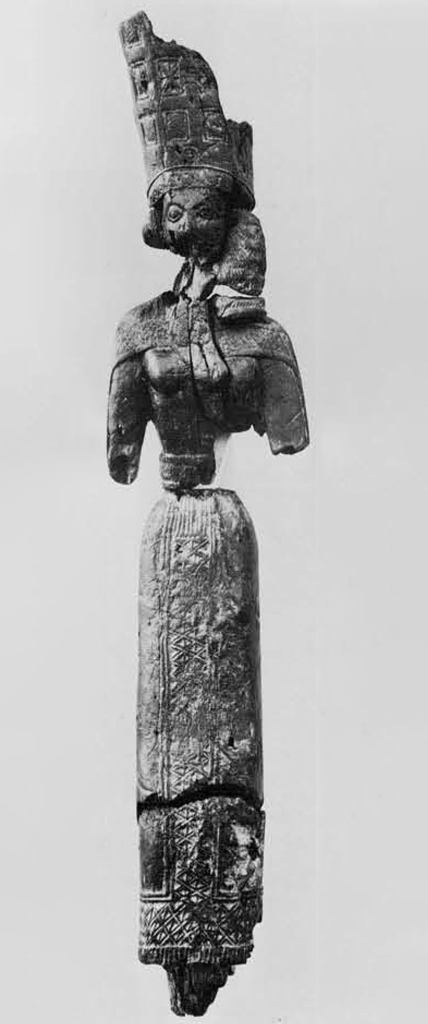
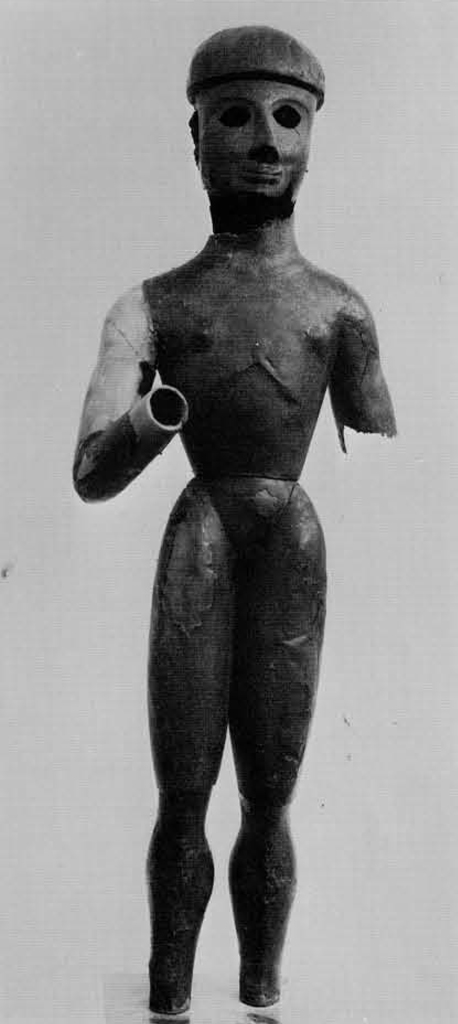
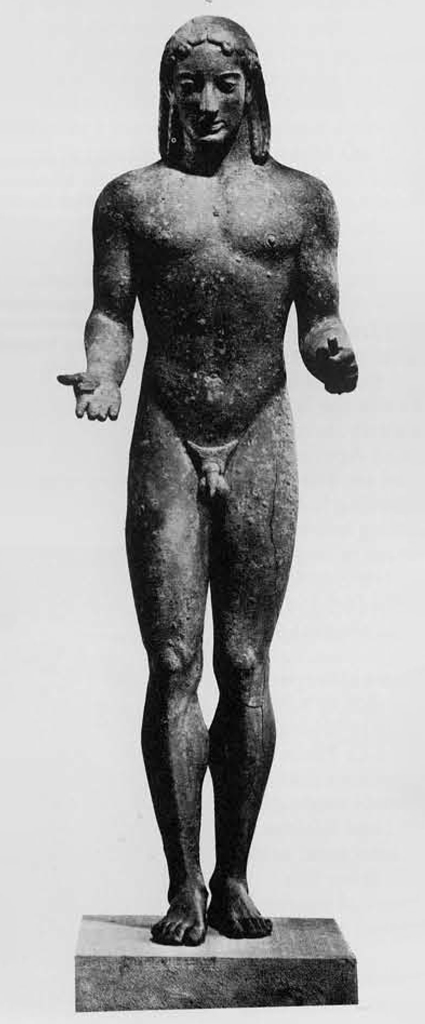
The Palladian of Troy belongs to the realm of legend, but there were many actual Greek xoana which were assigned fabled beginnings as if to imbue them and the cults of those deities with greater sanctity. Some, such as the xoanon of Athena Polias in Athens and Artemis at Ephesos, were said to have dropped from the sky like the Palladian; others are claimed to have been discovered at sea and dragged ashore in the nets of fishermen. The origins of many xoana are linked with various figures from Greece’s legendary past. For example, the xoanon of Aphrodite at Argos was reported to have been made by Epeios, the maker of the famous Trojan horse, and the xoanon of Aphrodite on Delos was said to have been made by Daidalos, the inventor of the Cretan labyrinth, to have been carried off by Ariadne on her escape from Crete, and set up by Theseus, the legendary founder of the city of Athens.
When the first wooden idols were made is not exactly known. Xoana may have existed in the Bronze Age, if we can credit the testimony of Greek and Roman writers who hark back to Greece’s mythical age to establish their origins. Recently, excavators of the Minoan shrine at Archanes in Crete have suggested, on the basis of the discovery of a pair of life-sized terracotta feet, that the idol of the shrine had a wooden body which was outfitted with these terracotta feet. If xoana did exist in the Bronze Age, the link between them and the earliest known Iron Age xoana is still missing. From literary evidence it is possible to date the two earliest known xoana, the statue of Hera at Samos and the image of Athena Polias in Athens, to the beginning of the 8th century B.C. No wooden statues survive from the 8th century, although several from the 7th and 6th centuries are preserved from Samos (Fig. 6) and Palma di Montechiaro in Sicily. None of these are idols, and in fact no wooden idols survive at all. Ancient writers would have us believe that xoana were simple, downright crude idols, mere lumps of wood. No doubt some were simple, but the very high quality of these surviving wooden statuettes attests to the abilities of the ancient Greeks to execute very fine works in wood.

The literary sources tell us that xoana were made of various kinds of wood, including olive, ebony, cypress, cedar, oak, yew, lotus and juniper. Xoana could be gilded, and it is possible that they were often painted, possibly to highlight physical features—skin, hair, eyes or mouth—or to render clothing, shoes or jewelry when cloth garments and real accessories were not provided. At least this is the impression one receives from vase paintings which often depict archaic-looking xoana as brightly painted figures. Xoana could be colossal, like the eight-foot-high Hermes on Mount Kyllene in Arcadia, but were more often quite small. Although there were no rules regarding the proper size for an idol, the earliest Greek idols were in general less than life-size, It was not until the late 7th or early 6th century that larger than life-size and colossal idols are known. Xoana (and early images of materials other than wood) could be made either in a seated or standing position, although male idols in the early period (with the exception of the wine-god Dionysos) rarely sat. Xoana, and idols in general, normally carried one or more symbols or ‘attributes’ in order to identify the deity and signal their specific nature. Head apparel sometimes served much the same purpose. A helmet, for example, is an obvious symbol of a warrior divinity and was commonly worn by early images of Zeus, Apollo and many idols of Sparta.
Xoana were made after the 6th century B.C., but the popularity of wood as a sculptural medium was eclipsed by the use of other materials such as bronze, stone, gold and ivory. Bronze was an acceptable and common material for idols from the 8th through the 6th centuries. One of the few surviving statues which may plausibly be identified as an idol from this period, a small (80 centimeters high) image of Apollo found in a temple at Dreros in Crete, is made of bronze, hammered in sheets in a technique called `sphyrelaton’ (Fig. 7]. It was discovered together with two nearly identical female statuettes, often recognized as the goddesses Artemis and Leto, the sister and mother of Apollo. All three statuettes can be dated in the 8th century B.C.
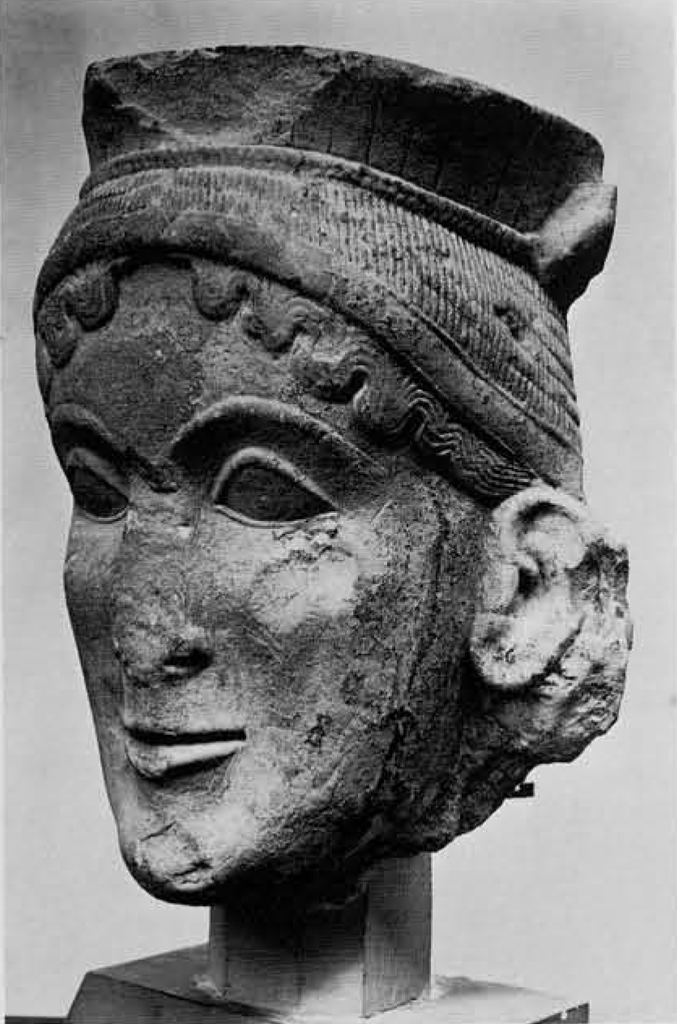
The hollow casting of bronze sculpture was introduced in the course of the 7th century B.C„ but it was not until around the mid-6th century, when the use of the lost-wax method of hollow-casting can be documented, that idols were commonly manufactured of hollow bronze. It is with this technical innovation that it was possible to cast bronze statues in progressively larger sizes. A just over life-size statue of Apollo found accidentally during construction in the Piraeus, the port of Athens, illustrates well what a bronze idol of the 6th century might have looked like (Fig. 8). It is naked and stands with one leg slightly advanced and both arms held forward from the elbows. In the upturned right palm is a remnant of what appears to have been a libation bowl (phiale), while in the left are the remains of a bow, the attribute most often associated with the god of Apollo. A South Italian vase painter of ca. 380 B.C. created a remarkably convincing look-alike of the Piraeus Apollo standing inside a temple. The figure on the vase is larger than life-size, to judge from its relationship to the architecture, and is rendered in brown and gold paint as if to suggest a gilded bronze statue. (Fig. 9).
With the exception of non-anthropomorphic idols, idols made of marble or of any other type of stone were rare in Greece until late in the 6th century B.C. Plutarch (1st to 2nd century A.D.) explains that the early Greeks, thought that idols made of stone were “hard, awkward and lifeless.” Dedicatory statues and architectural sculptures were obviously exempt from this prejudice since great numbers of marble and limestone statues survive from the 7th and 6th centuries.
A twice life-size female head has, since it was discovered at Olympia over a century ago, have been attributed to the early idol of Hera which Pausanias saw in her temple in the 2nd century A.D. (Fig. 10). The head is made of limestone and dates to ca. 590 B.C. Pausanias reported that the image of Hera was seated on a throne and that a bearded and helmeted Zeus stood beside her. A much neglected bit of evidence which proves that this stone head cannot have belonged to the early idol of Hera is the statue base which survives inside the Temple of Hera (Fig. 11). Calculations of the possible range in the width (front to back) of an enthroned figure with bodily proportions suitable for the twice life-size head, compared to the width of the base show that a statue of such a size could not fit on this rather small base. With the elimination of this early 6th century limestone head from Olympia as a fragment of an idol we eliminate the earliest evidence for the use of stone as a material suitable for an idol, and thus the first stone anthropomorphic idols that we know of appear around the last quarter of the 6th century B.C.
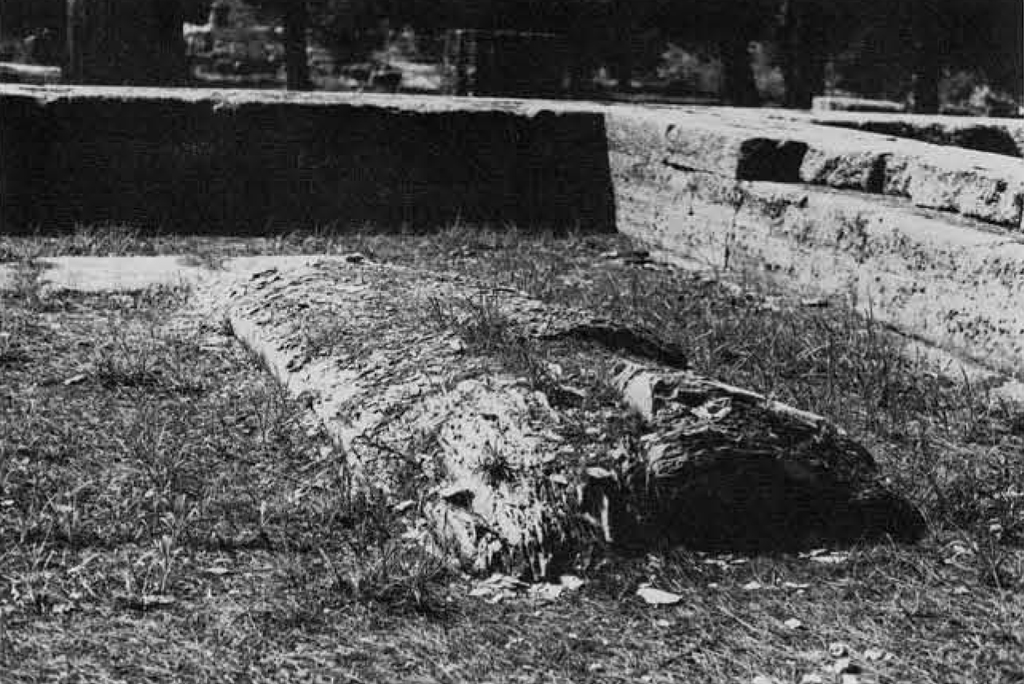
Chryselephantine idols made of a combination of gold and ivory (ivory for the flesh parts and gold for the clothing, accessories and details) are often associated only with the Classical Period and the famous Pheidian statues of Zeus in Olympia and Athena Parthenos in Athens. These colossal 5th century, and other 4th century works were, however, foreshadowed in the 6th century by chryselephantine idols. Ancient authors mention the existence of early cult images of gold and ivory and the discovery in 1939 in the sanctuary of Delphi of several life-sized chryselephantine votive statues dating to the 6th century confirmed archaeologically that gold and ivory were used in combination by the Greeks as a sculptural medium in the Archaic Period.
With the end of the 6th century and the dawn of the Classical Age, certain changes become so apparent in religious cults, and attitudes toward cult idols alter somewhat. One clue to these changes comes in the frequency with which old idols, xoana of the 8th, 7th, and 6th centuries, are ‘supplemented’ by the new extravagant images of gods and goddesses, designed to strike awe in the hearts of humble man, to display in a conspicuous manner the political superiority, economic prosperity or religious fervor of a city or sanctuary and, most importantly, to provide for Greek worshippers a more impressive and therefore more persuasive presentation of the Greek gods in idealized anthropomorphic forms. The statue of Athena Parthenos made by Pheidias and set up in the Parthenon on the Athenian Acropolis in the 430s is perhaps the most extreme example of the new type of image, created not to replace the very old and venerable xoanon, but to supplement it (Fig. 12). The new image of Athena was made of gold and ivory and rose nearly forty feet in height from an elaborate marble base. Athena wore a large gold helmut adorned with fantastic animals, a golden peplos and sandals. At her left side was a shield of gilded bronze on which were scenes of the mythical battles of the Greeks against the Amazons and the gods against the Giants. In the palm of her outstretched right (ivory) hand was a six-foot high gold and ivory statue of Nike, the bearer of Victory (Fig. 13). This very theatrical image of Athena must certainly have been awe-inspiring, but there is no doubt that it was the xoanon of Athena Polias which continued to serve as the embodiment of the city goddess of Athens and that the older statue was still the focus of worship on the Athenian Acropolis.
The story of idols does not end here. In fact, the evidence for the appearance of cult idols becomes more plentiful for the Classical, Hellenistic and Roman Periods. Statues which can be securely identified as idols are preserved from these periods, and literary sources are more explicit in their descriptions of later images. It is clear, however, from Greek and Roman writers that, despite the perishable nature of many of the earliest cult idols, their rate of survival into the Late Hellenistic and Roman Periods was surprisingly high, and that early idols, in particular wooden ones, continued to be worshipped and, in fact, gained still more sanctity because of their antiquity and their purported origin in the dawn of Greek civilization.
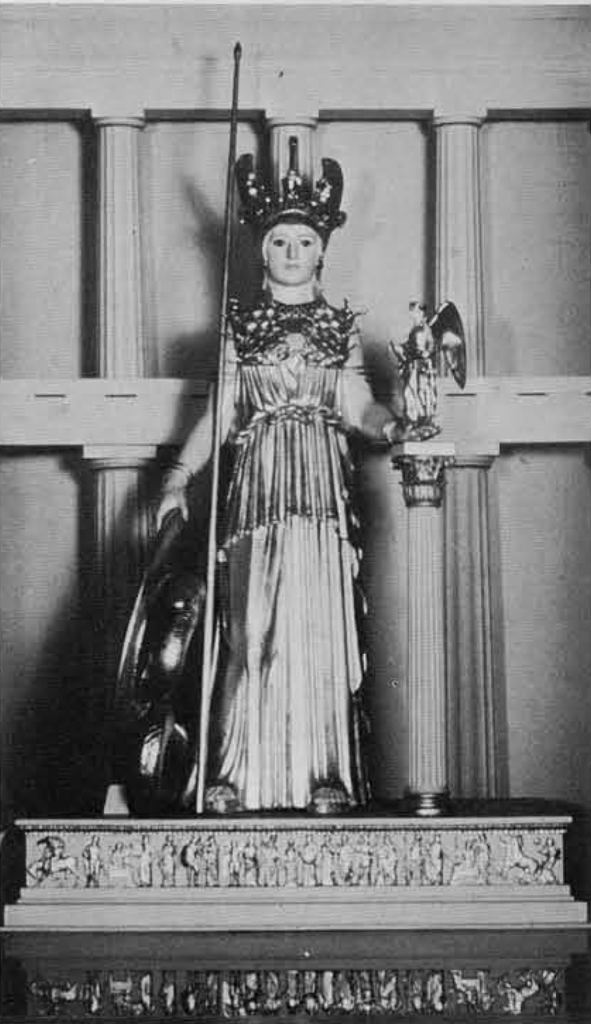
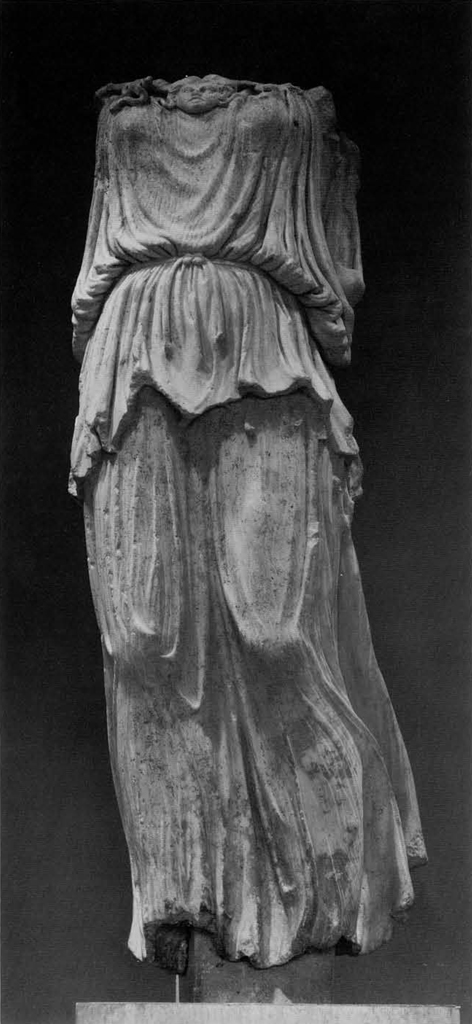
On preserved wooden statuettes: G. Ceputo. “Tre xoana e il culto di una sorgente sulfurea in territorio Geloo-Agrigentino,” Monumenti Antichi 37 (1936): 567-664; Giinter Kopcke. “Neue Holzfunde van Samoa,” Mitteilungen des deutschen archaologischen lnstituts, Athenische Abteilung 62 (19671: 100-146: Dieter Ohly, “Die Giittin und ihre Basis.” Mitteilungen des deutschen archaologischen instituts, Athenische Abteilung 68 (1953): 25-50.
On idols represented on coins: Leon Lacroix, Les reproductions de statues sur les monnaies grecques (Faculté de Philosophie et Lettres. Liege 1949].
On idols represented on vases: Karl Scheiold, “Statuen auf Vasenbildern.” Jahrbuch des k. deutschen archlaologischen lnstituts 52 (1937): 30-75: G. Schneider-Henmann, Kultstatue im Tempe] auf italischen Vasenbildern,” Bulletin Antieke Beschaving 47 (1972): 31-42.
